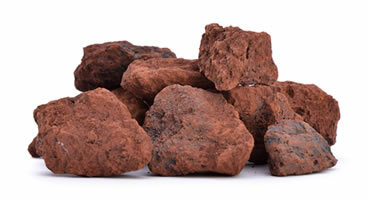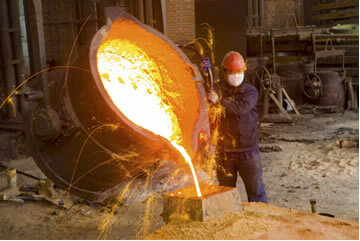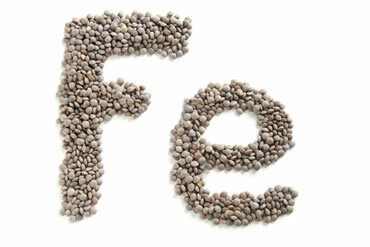Iron is a chemical element with an atomic number of 26, a molar mass of 55.845 g/mol, a melting point of 1535 °C and a boiling point of 2862 °C. This metal is very important in our society, as there are many different objects that contain iron in their constitution. It can be in its pure form or forming the metallic alloy called steel (formed by approximately 98.5% iron, 0.5 to 1.7% carbon and traces of silicon, sulfur and oxygen).
Iron has been used since the earliest times, around 4000 to 3500 BC. Ç. At that time, iron was obtained from meteors and was considered extremely rare.
Despite being the fourth most abundant element in the earth's crust, iron is not found isolated in nature, but only in ores, the main ones being: hematite (Fe2O3 – image below), magnetite (Fe3O4), siderite (FeCO3), limonite (Fe2O3.H2O) and pyrite (FeS2).

Hematite, an iron ore
From these ores, it is possible to produce the metal iron. This obtaining of a metal through its ores is made with various elements, such as aluminum, copper, titanium and manganese; and this process is studied by the area of
metallurgy. A branch of metallurgy that deals only with obtaining iron and steel is the steel industry, and the main ore used is hematite, as in the case of the image below:
Iron production from hematite in steelmaking
In steel mills, steel has a higher priority than iron in production, because this alloy can be worked in forging, rolling and extrusion, whereas with iron this is difficult. Steel also has greater hardness and high mechanical strength. To improve further, these materials (iron and steel) are even less costly than other high strength metals and alloys.
That's why they are so applied in our daily lives, especially in civil construction. For example, to build multi-story buildings as we see today in large urban centers, the reinforced concrete, which is concrete with steel frames. It is the steel that provides the strength the structure needs to withstand perpendicular forces such as winds.

Reinforced concrete used in civil construction
Hematite and magnetite are also used as catalysts for chemical processes, accelerating these reactions.
The iron, or rather the iron ion (Fe+2), it is very important for our health and life maintenance. It is this ion that keeps the hemoglobins in our blood working and makes it possible for them to extract oxygen from the air as the blood passes through the lungs, to distribute it throughout our bodies. The perfect functioning of the brain also depends on the iron ion.
Generally, it is not necessary for a normal person to take iron supplements, as the daily diet already provides the amount we need, as a standard man needs 10mg of iron a day, and a standard woman needs 18mg (in the case of pregnant women, they need more iron.) In addition, excess iron it can also bring health problems, such as increased risk of cancer, degenerative diseases, such as Parkinson's disease, and the impairment of some normal functions of the body.
Some foods that act as sources of iron are: liver, jerky, iron-fortified breakfast cereals, beans, raisins, bread, eggs, lentils, peas, beets, dark leaves such as spinach, kale, watercress and broccoli; in addition to fish.

Lentil is a food source rich in iron
To get an idea of how important iron is to life, consider the following: In the 1980s, scientist John Martin said there was no plankton in the upper regions of the oceans due to lack of iron and, consequently, without plankton, other forms of marine life do not. developed. In the 1990s, they fertilized 60 km2 of the Pacific Ocean with iron sulfate, and the result was that within a week the region bloomed and turned green thanks to the plankton that developed.
By Jennifer Fogaça
Graduated in Chemistry

